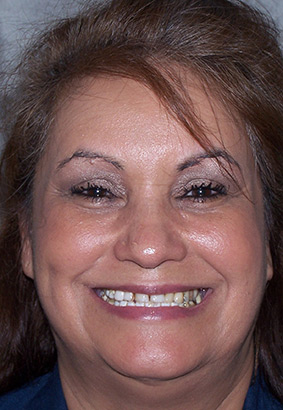As teeth wear down, wrinkles can become more prominent, causing some individuals to look older than they actually are. For an age-related full mouth rehabilitation procedure, our cosmetic dentist, Robin Rutherford, DDS, first evaluates the shape of each patient’s face to determine their candidacy for the procedure. He takes into account all elements that may affect a person’s smile and facial aesthetics, including age, skin tone, lip volume, and size and placement of their teeth.
- Dental Signs of Aging
- Full Mouth Rehabilitation Benefits
- Full Mouth Rehabilitation Candidates
- Full Mouth Rehabilitation Treatment Options
- Full Mouth Rehabilitation Results
- Full Mouth Rehabilitation vs. Smile Makeover
What Are Common Signs of Aging in Your Dentition?
Dental health and aesthetics can naturally decline with age, and there are often common signs that your smile’s well-being may be diminishing as you get older. Cosmetic concerns that can arise include yellow stains or discoloration, short or worn-down teeth, and cracks and chips. Additionally, bite irregularities can lead to other signs of facial aging, such as wrinkles around the mouth. As the jaw becomes weaker over time, the bone can also begin to recede. Fortunately, many of these common concerns can be improved with cosmetic and restorative dental care.
What Are the Benefits of Age-Related Full Mouth Rehabilitation?
The aging process naturally compresses facial features and is one of the reasons patients notice more wrinkles and a loss of facial volume. With comprehensive full mouth rehabilitation geared towards aesthetic issues, Dr. Rutherford is able to address the following areas of concern as he improves overall aesthetic appearance and function:
- Create a stronger jawline
- Improve speech through altered teeth structure
- Refine bite coordination for improved comfort
With full mouth rehabilitation, Dr. Robin Rutherford is able to create natural-looking and long-lasting results for many individuals. The entire makeover can typically be completed in two office visits, and can help patients enhance their appearance without the pain or downtime often associated with other more invasive procedures.
Who Is a Candidate for Full Mouth Rehabilitation?
A candidate for age-related cosmetic full mouth rehabilitation is typically someone experiencing facial sagging or early signs of aging due to tooth loss or significant dental wear. This procedure can be beneficial for individuals who wish to restore facial volume and support that has been lost over time. By using dental restorations such as dental implants, crowns, or veneers, full mouth rehabilitation can help improve jaw alignment, support facial structure, and enhance overall aesthetics. Ideal candidates are generally in good oral and overall health, non-smokers, and those without health conditions that could hinder healing. A consultation with Dr. Rutherford can help determine candidacy.
What Are Treatment Options in Age-Related Full Mouth Rehabilitation?
There are multiple procedures and treatments that can be part of full mouth rehabilitation focusing on aesthetic concerns, depending on your unique needs and goals. Here are some of the more popular options available at The Art of Dentistry:
- Porcelain veneers can address a variety of cosmetic concerns, including discoloration, misalignment, and short or worn-down teeth. The precise placement of veneers can help lengthen facial structure and teeth, often helping to reduce visible signs of aging.
- Porcelain crowns can improve overall dental structure and the jawline appearance by increasing jaw height. In turn, these adjustments can also enhance the look of the lips and cheeks in some individuals.
- Gum reshaping can help teeth look more proportional, create a more symmetrical gumline, and reduce the appearance of excess gum tissue. The treatment can also provide better access to decayed teeth so the natural tooth structure can be reinforced.
- Teeth whitening treatment is a common way to enhance the appearance of your smile. Time, certain foods and beverages, and specific medications can lead to tooth stains and discoloration. Professional whitening treatment can help produce brighter and healthier-looking teeth.
- Six Month Smiles® is an orthodontic treatment that specifically targets visible teeth, instead of all teeth. The tooth-colored brackets and wires can improve misalignment in a shorter time period than other options for a better bite and straighter teeth.
How Long Do Age-Related Full Mouth Rehabilitation Results Last?
The longevity of full mouth rehabilitation results can vary widely, depending on the type of dental treatments used and a patient’s oral health and lifestyle. In most cases, results can last many years. High-quality dental restorations such as dental implants, crowns, and veneers can often last for 10 to 15 years or more with proper care. Maintaining good oral hygiene, regular dental check-ups, and avoiding habits that could damage the teeth, including teeth grinding or chewing hard objects, are key to prolonging the effects of full mouth rehabilitation.
What Are the Differences Between Full Mouth Rehabilitation and a Smile Makeover?
While full mouth rehabilitation and smile makeover can improve cosmetic elements of a patient’s smile, they typically serve different purposes and involve different approaches. Full mouth rehabilitation is primarily aimed at rebuilding and bettering a patient’s teeth and overall oral health. Age-related changes can be addressed to help restore the structure and function of the jaw and teeth, thereby improving facial support and contours. It often involves significant restorative work to enhance the facial profile.
In contrast, a smile makeover mostly focuses on enhancing the aesthetics of the smile itself. It typically involves just cosmetic procedures such as teeth whitening, veneers, and aligning the teeth to improve the overall appearance of the smile. While a smile makeover can enhance dental aesthetics, full mouth rehabilitation provides structural corrections and anti-aging benefits.
Contact The Art of Dentistry
To find out more about cosmetic full mouth rehabilitation and how this procedure can help you achieve the smile you’ve always wanted, as well as the younger appearance you desire, contact The Art of Dentistry today.








